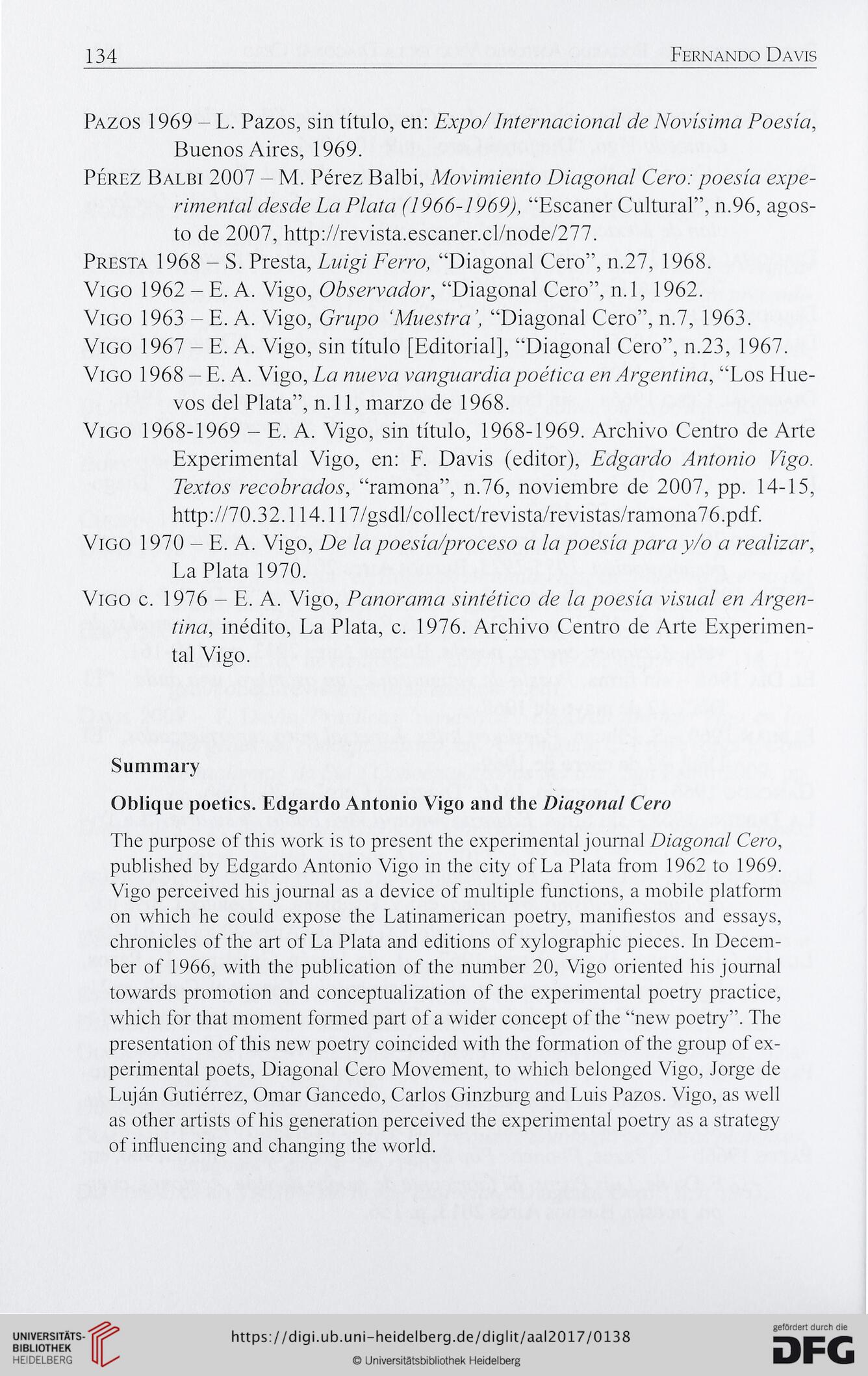134
Fernando Davis
Pazos 1969 - L. Pazos, sin título, en: Expo/Internacional de Novísima Poesía,
Buenos Aires, 1969.
Pérez Balbi 2007 - M. Pérez Balbi, Movimiento Diagonal Cero: poesía expe-
rimental desde La Plata (1966-1969), “Escáner Cultural”, n.96, agos-
to de 2007, http://revista.escaner.cl/node/277.
Presta 1968 - S. Presta, Luigi Ferro, “Diagonal Cero”, n.27, 1968.
Vigo 1962 - E. A. Vigo, Observador, “Diagonal Cero”, n.l, 1962.
Vigo 1963 -E. A. Vigo, Grupo ‘Muestra’, “Diagonal Cero”, n.7, 1963.
Vigo 1967 - E. A. Vigo, sin título [Editorial], “Diagonal Cero”, n.23, 1967.
Vigo 1968 - E. A. Vigo, La nueva vanguardia poética en Argentina, “Los Hue-
vos del Plata”, n.l 1, marzo de 1968.
Vigo 1968-1969 - E. A. Vigo, sin título, 1968-1969. Archivo Centro de Arte
Experimental Vigo, en: F. Davis (editor), Edgardo Antonio Vigo.
Textos recobrados, “ramona”, n.76, noviembre de 2007, pp. 14-15,
http://70.32.114.117/gsdl/collect/revista/revistas/ram ona76.pdf.
Vigo 1970 - E. A. Vigo, De la poesía/proceso a la poesía paray/o a realizar,
La Plata 1970.
Vigo c. 1976 - E. A. Vigo, Panorama sintético de la poesía visual en Argen-
tina, inédito, La Plata, c. 1976. Archivo Centro de Arte Experimen-
tal Vigo.
Summary
Oblique poetics. Edgardo Antonio Vigo and the Diagonal Cero
The purpose of this work is to present the experimental journal Diagonal Cero,
published by Edgardo Antonio Vigo in the city of La Plata from 1962 to 1969.
Vigo perceived his journal as a device of multiple functions, a mobile platform
on which he could expose the Latinamerican poetry, manifiestos and essays,
chronicles of the art of La Plata and editions of xylographic pieces. In Decem-
ber of 1966, with the publication of the number 20, Vigo oriented his journal
towards promotion and conceptualization of the experimental poetry practice,
which for that moment formed part of a wider concept of the “new poetry”. The
presentation of this new poetry coincided with the formation of the group of ex-
perimental poets, Diagonal Cero Movement, to which belonged Vigo, Jorge de
Lujan Gutiérrez, Omar Gancedo, Carlos Ginzburg and Luis Pazos. Vigo, as well
as other artists of his generation perceived the experimental poetry as a strategy
of influencing and changing the world.
Fernando Davis
Pazos 1969 - L. Pazos, sin título, en: Expo/Internacional de Novísima Poesía,
Buenos Aires, 1969.
Pérez Balbi 2007 - M. Pérez Balbi, Movimiento Diagonal Cero: poesía expe-
rimental desde La Plata (1966-1969), “Escáner Cultural”, n.96, agos-
to de 2007, http://revista.escaner.cl/node/277.
Presta 1968 - S. Presta, Luigi Ferro, “Diagonal Cero”, n.27, 1968.
Vigo 1962 - E. A. Vigo, Observador, “Diagonal Cero”, n.l, 1962.
Vigo 1963 -E. A. Vigo, Grupo ‘Muestra’, “Diagonal Cero”, n.7, 1963.
Vigo 1967 - E. A. Vigo, sin título [Editorial], “Diagonal Cero”, n.23, 1967.
Vigo 1968 - E. A. Vigo, La nueva vanguardia poética en Argentina, “Los Hue-
vos del Plata”, n.l 1, marzo de 1968.
Vigo 1968-1969 - E. A. Vigo, sin título, 1968-1969. Archivo Centro de Arte
Experimental Vigo, en: F. Davis (editor), Edgardo Antonio Vigo.
Textos recobrados, “ramona”, n.76, noviembre de 2007, pp. 14-15,
http://70.32.114.117/gsdl/collect/revista/revistas/ram ona76.pdf.
Vigo 1970 - E. A. Vigo, De la poesía/proceso a la poesía paray/o a realizar,
La Plata 1970.
Vigo c. 1976 - E. A. Vigo, Panorama sintético de la poesía visual en Argen-
tina, inédito, La Plata, c. 1976. Archivo Centro de Arte Experimen-
tal Vigo.
Summary
Oblique poetics. Edgardo Antonio Vigo and the Diagonal Cero
The purpose of this work is to present the experimental journal Diagonal Cero,
published by Edgardo Antonio Vigo in the city of La Plata from 1962 to 1969.
Vigo perceived his journal as a device of multiple functions, a mobile platform
on which he could expose the Latinamerican poetry, manifiestos and essays,
chronicles of the art of La Plata and editions of xylographic pieces. In Decem-
ber of 1966, with the publication of the number 20, Vigo oriented his journal
towards promotion and conceptualization of the experimental poetry practice,
which for that moment formed part of a wider concept of the “new poetry”. The
presentation of this new poetry coincided with the formation of the group of ex-
perimental poets, Diagonal Cero Movement, to which belonged Vigo, Jorge de
Lujan Gutiérrez, Omar Gancedo, Carlos Ginzburg and Luis Pazos. Vigo, as well
as other artists of his generation perceived the experimental poetry as a strategy
of influencing and changing the world.




